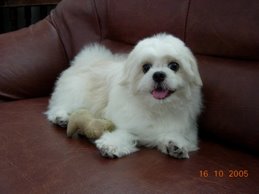Article From SubmitYOURArticle.com: Pomeranian Dog Breed Profile
Description: The Pomeranian is a small Spitz dog
weighing between 3 and 7 pounds, and measuring 7
to 12 inches at the withers. The Pomeranian has a
long, fluffy coat that can be found in many color
varieties such as orange, cream, black, red,
spotted, and white. This dog carries its
plume-like tail flat on its back. Pomeranians
have a short, pointed muzzle, and small, upright
pointed ears. This is a confident and active toy
dog. The Pomeranian has a delicate body
structure. The Pomeranian is also known as the
Dwarf Spitz, Pom, or Loulou.
History: Ancient Spitz herding dogs led to the
toy dog we know today as the Pomeranian.
Originally utilized as sled dogs in Lapland,
these Spitz dogs were brought to Pomerania, now
part of Poland and Germany, in the 16th century.
This early progenitor was considerably larger
than today's dog and weighed 30 pounds or more.
Mozart and Marie Antoinette kept Pomeranians, but
it was Queen Victoria of England who was
responsibly for breeding the dogs down to a
smaller size. These small Pomeranians became very
popular and the breed was officially recognized
in 1900.
Temperament: The Pomeranian is a merry and lively
dog. It is even-tempered and makes an excellent
companion. Pomeranians are very affectionate and
attached to their human family. This is an
intelligent, trainable dog that also serves as a
good watchdog. They do tend to bark quite a bit,
though, so should be taught to be more restrained
from the start. Since the Pomeranian is such a
tiny dog, it is not a good choice as a pet for
small children. There is generally no problem
with older children or adults.
Health Issues: A major health problem with
Pomeranians concerns the breed's high propensity
for tooth decay. This can lead to heart or kidney
ailments. It is best to feed Poms dry dog food
and provide chews that help clean the teeth.
Although they do not usually suffer from hip
dysplasia, Pomeranians can experience problems
with their knee caps, which can shift out of
place, causing the affected leg to become stiff.
The Pomeranian can develop eye conditions such as
cataracts or entropion. The trachea can sometimes
collapse, which is a serious condition. The
Pomeranian can live for 16 years or more.
Grooming: Since the Pomeranian has a very thick
double coat and sheds heavily, it is important to
brush the dog daily. The fur can easily become
matted otherwise. It is best to use a dry shampoo
on the Pomeranian to preserve the dog's coat
oils. The owner should clean the ears and eyes
every day to help prevent infections. While a
daily brushing of the teeth can help prevent
decay, a veterinarian should clean the teeth on a
regular basis.
Living Conditions: The Pomeranian makes an
excellent companion for indoor living. The dog
will play and exercise itself in an apartment or
house, but the Pom will enjoy and occasional walk
or play session outside. While these dogs are not
clingy, they definitely enjoy being around their
family. They must be kept inside, and are not
suitable for outdoor living.
----------------------------------------------------
For more information on the Pomeranian, Training
and Puppies for sale visit the page below.
http://www.scottspuppypalace.com
EasyPublish this article: http://submityourarticle.com/articles/easypublish.php?art_id=87207














.jpg)






.jpg)

0 comments:
Post a Comment